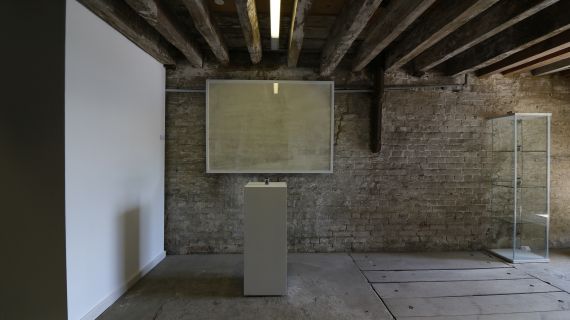
Changing Places at The House Mill. Photographer: Catarina Rodrigues.
Exhibition
Changing Places is a series of exhibitions staging contemporary artists’ moving image within eight historic buildings across the country.
The tour begins at The House Mill, London, with a newly commissioned installation by Imran Channa and four video works, by Bani Abidi, Omar Chowdhury and Desire Machine Collective, presented throughout the Grade 1 listed 18th century tidal mill. Specially arranged guided tours will lead visitors through narrow passageways to view one of the works inside the 'Grain Bins', in the heart of the mill.
The national tour features artists who live in, work in, or retain a connection to Bangladesh, India or Pakistan. Presented in 2017, during the 70th anniversary of Indian independence, these artists’ works cover a range of perspectives and situations, from international migration and border-transcending environmental impacts, to the individual who navigates and responds to shifting social and economic circumstances. Through the pairing of specific sites and artworks, Changing Places bridges the chronological and geographical gaps between the industrialisation currently occurring across South Asia, and the places in Britain where the blueprint began.
Read more about each of the works on show at The House Mill below.
Through its production of gunpowder, flour and grain, The House Mill historically attracted newcomers with an offer of work, leading to additional housing and the structuring of communities around the ‘hub’ of the Mill. The video work Locus, Temple, by artist Omar Chowdhury, features a similarly central building at the heart of community life, with space for work, medical treatment and worship. Back in the London Borough of Newham, developers sought to transform the local area into a ‘district centre’, which would have put consumerism, rather than production, at the forefront of the area’s regeneration. Chowdhury’s film therefore offers an interesting counterpoint to the creation of a society based on individualism, expressed through material ownership. Instead, it shows individuals involved in a personal transformation that goes beyond the surface, and highlights how ritual activities contribute to a form of community and collectivism.
STONEWORK, also by Omar Chowdhury, resonates with the physical construction underway in the area. As buildings of polished glass and steel rise to transform the skyline, this video work acts as poignant reminder of the physical labour and natural materials that are at the heart of the construction process.
Imran Channa has been commissioned to make a series of new works responding to a number of the locations on the tour, including The House Mill. The artist accessed items from the venue's archives, and was given permission to remove small samples of dust from deep within the building. His resulting artwork brings together residual material, an erased drawing of Crystal Palace and an audio work that references once popular fictional stories about international exploration.
Desire Machine Collective’s video work Residue presents the crumbling, forgotten, yet monumental space of a former power station. The work shows this vast redundant thermal power plant being reclaimed and transformed by nature in the absence of any will for preservation.
On Saturdays and Sundays, guided tours will lead visitors through narrow passageways to a fourth moving-image work within the Grain Bins on the upper floor of the mill. Here, in Bani Abidi’s The Distance From Here, we are invited to observe a group of people waiting to travel, though it’s never made clear exactly how, or why. As people continue to migrate to new destinations, either through economic necessity, political instability or adventure, the demographics of global cities continue to shift. But while sites of consumerism are filled with commodities that move across the planet under free trade agreements, Abidi’s film, The Distance From Here, illuminates the bureaucracy, obedience and ritualistic processes involved in restricting the free movement of people.
Read more about the Changing Places tour.
Read FVU director Steven Bode's take on the exhibition.
7 July 2017 – 16 July 2017
The House Mill, London
The Miller’s House, Three Mill Lane, E3 3DU
Exhibiting: The Distance from Here, Bani Abidi; Locus, Temple and STONEWORK, Omar Chowdhury; Residue, Desire Machine Collective; and a specially commissioned installation by Imran Channa.
Nearest tube: Bromley-by-Bow
Opening times: Tuesday - Sunday 11am - 5pm, closed Monday
Guided tours to The Distance From Here, by Bani Abidi, showing in the Grain Bins on the upper floor:
Saturday & Sunday only, starting at 12, 1, 2, 3 & 4pm
Admission and tours are free.
Please note that some areas of The House Mill are not fully accessible. The Grain Bins on the upper floor, where the guided tours take place, are not accessible for visitors who cannot walk unaided. With the exception of the ground floor cafe in the Miller’s House, the other exhibition spaces are only accessible via large stone steps.
Changing Places is a Film and Video Umbrella touring exhibition, supported by Arts Council England, Canal & River Trust, National Trust, City of Bradford Metropolitan District Council, Hastings Museum & Art Gallery, Phoenix Leicester, Feltech, Links Signs and Heritage Lottery Fund. Curated by Mariam Zulfiqar.